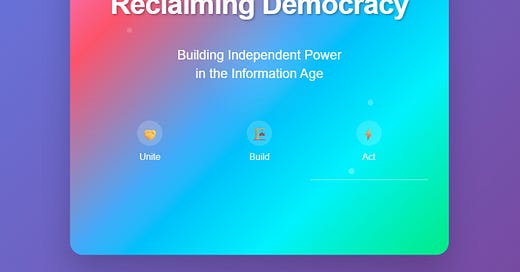Part 4: Lessons from American History
Reclaiming Democracy from Manufactured Confusion
Introduction
In Part 3, we saw why individual and institutional solutions fail against a system engineered to keep Americans divided and disoriented. History shows us that when the normal channels are captured, Americans have still found ways to win. Today, we'll explore the historical playbook that actually works—and how these lessons can guide us now.
How Americans Have Fought Captured Systems Before
You might be thinking: "This all sounds impossible. How can regular people challenge billionaires, foreign governments, and tech giants?"
The answer is in our American history. We've faced captured institutions before, and we've won—through building independent power and making the status quo too expensive to maintain, rather than through better arguments or individual choices.
The Pattern Every Successful Movement Followed
Successful movements shared a core playbook:
Economic Disruption: Imposing costs on the system they were challenging, making the status quo more expensive than reform.
Parallel Institution Building: Creating new institutions rather than trying to reform captured ones.
Cross-Coalition Organizing: Uniting people across traditional divides around shared threats.
Strategic Crisis Creation: Forcing moments where the system had to respond or face collapse.
Long-Term Persistence: Sustaining pressure for years or even decades.
Let's see how this played out in practice.
The Populist Movement: When Both Parties Were Captured
The Problem
In the 1890s, both major political parties were controlled by railroad and banking monopolies. Farmers and workers were getting crushed, while voting offered no relief because both options served the same corporate interests.
What They Built
Farmers' cooperatives that bypassed corporate middlemen, allowing them to buy supplies in bulk and break monopolies.
Mutual banks that provided fair credit.
Independent newspapers that told stories ignored by corporate media.
The Farmers' Alliance, which organized millions across the country over two decades.
How They Won
After years of building alternative economic power, their threat to abandon both major parties forced those parties to adopt populist positions or face irrelevance.
Key Insight
They built independent power that forced the parties to come to them, rather than trying to reform the captured parties.
The Labor Movement: When Government Sided with Business
The Problem
In the early 20th century, government consistently sided with industrialists against workers. Police broke up strikes, courts banned unions, and politicians ignored worker concerns.
The Long Road
Labor organizing required over 50 years of sustained effort, surviving violent suppression, legal attacks, company militias, and mass arrests.
What They Built
Parallel unions and worker organizations independent of government and business control.
Strike funds and mutual aid societies to support members during hard times.
National coalitions that could coordinate action across industries.
How They Won
Through persistent organizing and economic disruption—strikes, boycotts, and solidarity—they made it more costly for businesses and politicians to ignore workers than to negotiate with them.
The Civil Rights Movement: When the Law Was the Problem
The Problem
In the 1950s and 1960s, federal, state, and local governments enforced segregation and racial oppression.
What They Built
Parallel institutions like Black churches, newspapers, and civic organizations.
Cross-racial coalitions that united people around shared moral and economic interests.
Strategic campaigns that forced national crises, such as the Montgomery Bus Boycott and the March on Washington.
How They Won
By sustaining pressure through economic boycotts, legal challenges, and mass mobilization, they forced the system to respond and ultimately change.
The Common Thread
In each case, success came from building new, independent power—economic, social, and political—that made the status quo unsustainable, rather than from working within captured systems.
Actionable Takeaway
Study the Playbook: When today's institutions seem unresponsive or rigged, look to history. What independent organizations or coalitions can you help build? Where can you join with others to create real leverage outside the usual channels? The first step is connecting with others who share your concerns and are ready to act.
Transition to Part 5
In the final part, we'll translate these historical lessons into a modern playbook for reclaiming democracy. You'll discover actionable steps for building independent power in today's information environment—and how you can be part of the solution.



